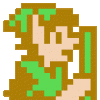Recently, I began working on an RTS. I'm using A* and it is working well, only I don't like how my paths contains long straight lines (both orthogonal and diagonal), shown in dark red below. I would prefer if the paths favoured more "jaggard" lines, as shown below in light brown.

It seems every other implementation of A* which I have seen actually favours jaggard lines by default, but for some reason mine doens't work that way, and as far as I can tell I am not doing anything differently. I can't paste my source because I am writing the game in Multimedia Fusion which doesn't use traditional code. But, I did base my "code" on this article, seemingly a pretty standard of version A*.
If anybody has any ideas why this is occuring, I'd love to hear about it!
Thanks in advance, Chris.
PS. Here is the executable if anybody is interested.










